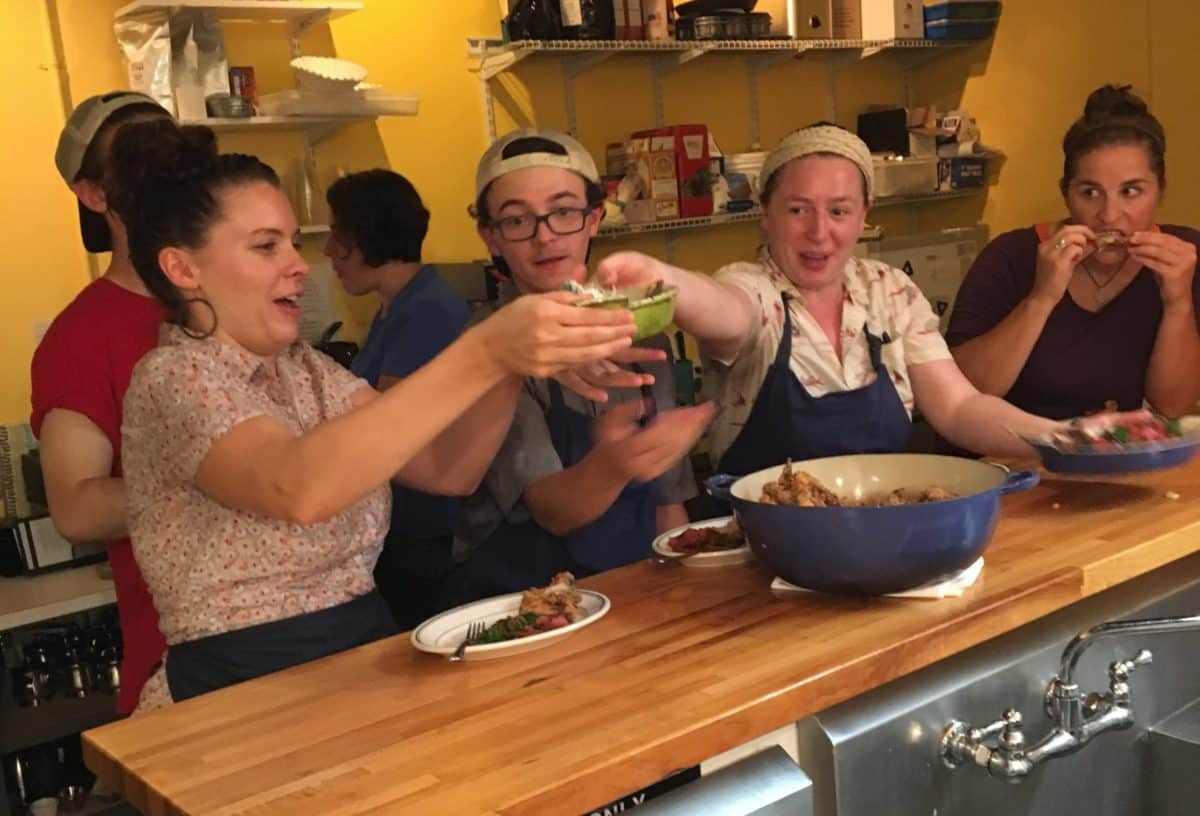My journey in the culinary world began in Maine, where the concept of a “family meal” was foreign. Back then, restaurants operated on a more individualistic dining system for staff. We were offered a discount, typically 50%, on menu items before or after our shifts. It was entirely up to us to ensure we were fed. If time allowed during quieter periods, we might quickly prepare something for ourselves, but there was no structured mealtime together.
It wasn’t until I enrolled in culinary school that I truly experienced the communal nature of family meal. Our classes were designed to be collaborative. We’d start with a lecture, then break into groups, each assigned different recipes. The culmination of our morning was preparing lunch for everyone. During “tasting time,” our chef instructors would guide us, offering critiques and praise on each dish. This wasn’t just about evaluating the food; it was a crucial learning environment. We learned as much from observing our classmates’ successes as we did from understanding and correcting our own mistakes. A broken beurre blanc became a lesson in emulsion recovery, a burnt bread crust a reminder of oven temperature control.
This shared meal went beyond culinary education. Tasting time was also when we, as students, took on responsibilities. We’d democratically decide who was in charge of cleanup, who would handle the requisitions for the next day’s ingredients. In a structured, often demanding environment, family meal was a moment of equality. From the seasoned instructors to the struggling students, we were all peers sharing a meal.
After culinary school, I landed an externship at The French Laundry. At the time, it was considered by many to be the pinnacle of dining, perhaps the best restaurant globally. Stepping into that kitchen, I felt woefully unprepared. While I was efficient at high-volume, “low-brow” cooking – think grills full of steaks and burgers – the precision required for fine dining knife work and using a mandolin left me lagging far behind my new colleagues.
The long flight from Maine to California’s Napa Valley (my first ever plane ride) amplified my anxiety. Had I overestimated my abilities? My first day began at 5:30 a.m. (a near-impossible start time for a 20-year-old). The morning was a blur of confusion in a cramped kitchen. I moved from station to station, working on assigned tasks, constantly doubting if I was doing anything correctly. Fear began to creep in. Was this my future? Why did I ever apply for this externship? How could I possibly manage in this tiny workspace, constantly shifting around?
Then, a kitchen colleague bumped my shoulder, saying, “Family’s up – go get some food.” I hadn’t even realized how hungry I was until that moment. I walked towards the pass and saw the ingredients for BLT sandwiches laid out on the very plating table where Chef Thomas Keller assembled his masterpieces. A few bites of simple white bread, homemade mayonnaise, crispy bacon, and juicy tomato, and I felt human again. BLTs, I understood. This familiar meal leveled the playing field with the more experienced cooks. It was a reminder that everyone starts somewhere. BLTs today, cauliflower panna cotta tomorrow, right?
The following week, I had my chance to cook family meal for everyone. I was given ten pounds of pork belly confit trim and fat to work with. Having never cooked with pork belly before, I drew inspiration from my dad’s diner-style “hash.” I rendered the pork, combined it with onions, Worcestershire sauce, and potatoes – a sort of deconstructed shepherd’s pie. It was rich, fatty, and comforting, and earned me some much-needed respect from the kitchen team, who were likely less than impressed with my novice knife skills.
For my next family meal opportunity, I aimed to impress further. This time, I received a pile of veal trimmings – tough, sinewy pieces best suited for grinding or slow cooking. I decided on a blanquette de veau. I browned the veal in flour and butter, slow-cooked it in white wine, stock, and cream, and served it with rice. The sous chefs were so enthusiastic that they asked me to make extra to freeze for future staff meals!
Being part of the family meal production was grounding during a whirlwind period in my life. More than any single culinary technique, it taught me that no matter how prestigious the restaurant or how intense the kitchen environment, everyone needs to eat, and everyone benefits from connecting with their team. Family meal became my confidence booster, a space for growth in a challenging new world.
 Staff Chicken Wings *Courtesy photo*
Staff Chicken Wings *Courtesy photo*
Six years later, after gaining experience in various kitchens, I became Chef de Cuisine at Brasserie Jo in Boston, located within the Colonnade Hotel in Back Bay. Large hotels often have dedicated staff cafeterias. The Colonnade’s cafeteria cook had been with the hotel for 15 years. His seniority allowed him to choose his schedule, and he opted for weekends off to spend with his family – a rare luxury in the demanding restaurant industry. This meant that every weekend, my sous chefs and I were responsible for cooking for the entire hotel staff, twice a day, during our busiest service hours.
The staff at the Colonnade and Brasserie Jo embodied the American dream – a diverse group from around the globe, working tirelessly to serve discerning guests. Cooking for them presented unique challenges, including a wide range of health and religious dietary restrictions. We also operated under a strict food budget and tight deadlines to accommodate different departments’ break schedules.
What might seem like a logistical nightmare was, for me, one of the most fulfilling periods of my cooking career. I connected with people from Morocco, Nepal, Cape Verde, El Salvador, China, and many other countries. My family meal menus became globally inspired. I utilized spices, lentils, rice, slow-cooked meats, and vegetables to create dishes that catered to everyone’s needs. I frequently prepared dishes like slow-cooked chicken legs with tomatoes and curried lentils, pork shoulder with ginger, scallions, and chilies, and pollock with capers and brown butter.
The greatest praise I received was when someone told me the food reminded them of home. I would overhear conversations in the hallways leading to the cafeteria, about how the aroma evoked childhood memories, how the food tasted like their mother’s or grandmother’s cooking. There were no fancy flourishes – no elaborate garnishes, no expensive ingredients, no culinary theatrics. But in those simple pans of food, I poured my respect for the community I was working with and felt honored to serve the dedicated individuals who served our guests throughout the week.
Now, as chef and owner of Thistle Pig, I find myself once again providing family meal for my crew. We operate in a small space, and multitasking prep, service, and deliveries with a small team is always challenging for a young business. For lunch, we stagger staff breaks to maintain service. Crew lunch is often quick and practical – sandwiches, omelets, or stir-fries; eggs are a lunchtime staple! For dinner, after the evening rush, I prepare enough food for everyone to share – a large pot of polenta with roasted vegetables, spicy miso noodles, meatballs, pasta with chilies and kale, and similar dishes.
 Passing the Family Meal *Courtesy photo*
Passing the Family Meal *Courtesy photo*
After a demanding day of hard work, front-of-house and back-of-house staff come together, share a meal, discuss the day’s successes and challenges, strategize for cleanup, identify prep tasks for after dinner and for tomorrow, and check on inventory needs. Sound familiar? It is an honor to feed my crew, to nourish them, and to make them feel valued after they have given their all to serving our community. Restaurants With Family Meals aren’t just feeding their staff; they are cultivating a culture of camaraderie, respect, and shared purpose that extends far beyond the kitchen.


